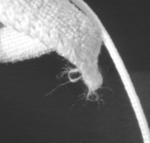The matter of diffraction and its effects on image sharpness comes up here periodically. I thought I’d share a little something on the matter.
Some of us work in in large format partly for the purpose of making very large prints, by which I mean 16x20, 20x24, and considerably larger. For those who do, it may be that every scintilla of sharpness is desired to accomplish the intention. Others of us lack the means to make such large prints, probably wouldn’t make them even if we could, and/or are not as concerned with ultimate sharpness as some others may be, for reasons of subject matter, style, or other considerations. I live in this camp, as primarily a portraitist with a maximum print size of 11x14. Nonetheless, I do photograph landscapes and other types of subjects occasionally, and the diffraction question has, I admit, quietly nagged me despite the sage words of more accomplished members assuring that loss of sharpness from diffraction rarely trumps inadequate depth of field in practical work.
Today I finally made a test. Using a still life concoction of suitable items arranged well within the depth of field at f/16, I exposed one negative at f/22 and one at f/45 on my standard film, HP5+. My developer is D-23. My lens is a 1960s or ‘70s 210mm Komura, a lens with a good reputation but by no means a wallet-stripping super-multi-coated Apo-Sharpenar from one of the top German or Japanese makers. I set up my enlarger with my 80mm Nikkor lens from the 1970s and made 5x7 prints from a section of the two negatives at about 5x, i.e., a 20x25-inch enlargement.
Guess what. Examining the prints close-up by eye, I can barely tell which is which. Only in the type on the little card can I sense that the f/45 images is not quite a sharp. The small, serif type, 8- or 9-point, is in the range of 1/64-inch high on the negative—all perfectly clear in the prints. But what really wiped away any doubt, is that some fine, individual hairs frayed from a microfiber cloth are also clearly visible. Remember that I’m staring from about six inches at a teency-tiny area on what would be a 20x24 print. I hope the scans will at least indicate what is visible in the prints. (By the way, I applied no sharpening to the scans and only adjusted the black point slightly since they are on semi-matte paper.)
So, for those of you coming into LF work, or film work at all, I hope I’ve helped to allay some of your concern about this little corner of the technical aspects of making art. Now you can spend more time worrying about composition, a much more challenging subject, in my view.
The detail images were scanned at 1200 ppi from an area about 1 1/4 inches on the 5x7 prints.




 Reply With Quote
Reply With Quote



Bookmarks